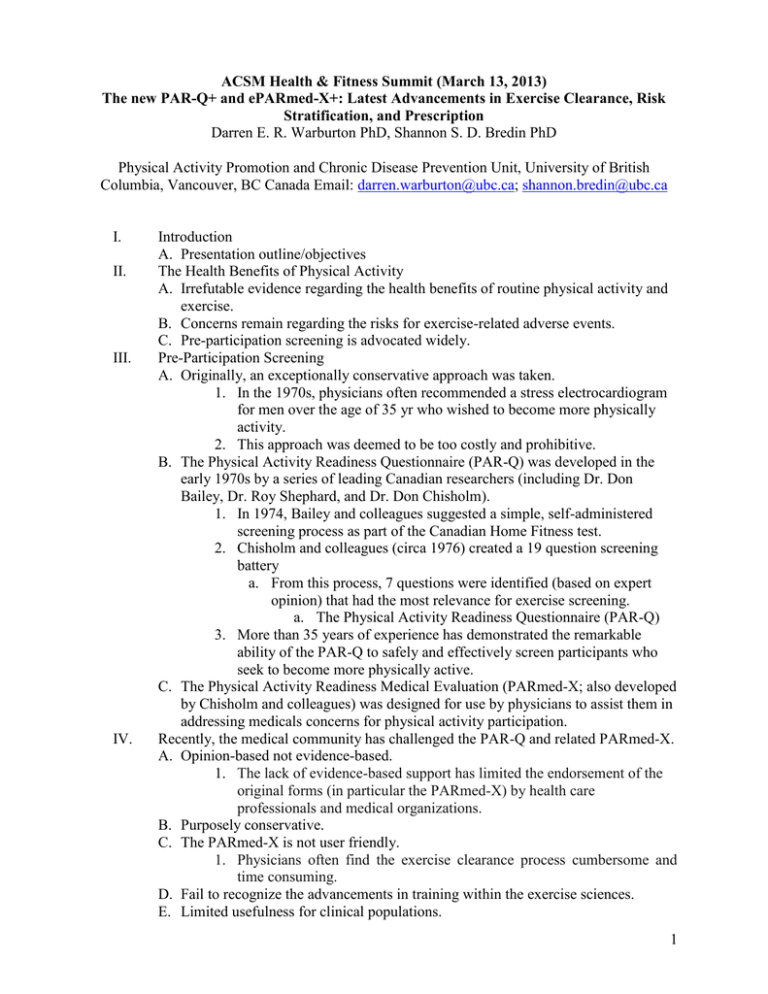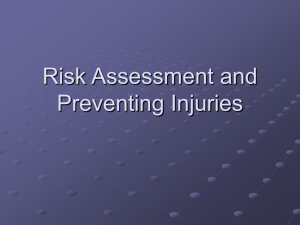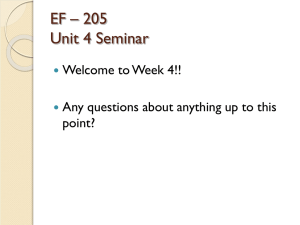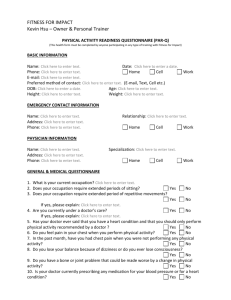ACSM Health & Fitness Summit (March 13, 2013)
advertisement

ACSM Health & Fitness Summit (March 13, 2013) The new PAR-Q+ and ePARmed-X+: Latest Advancements in Exercise Clearance, Risk Stratification, and Prescription Darren E. R. Warburton PhD, Shannon S. D. Bredin PhD Physical Activity Promotion and Chronic Disease Prevention Unit, University of British Columbia, Vancouver, BC Canada Email: darren.warburton@ubc.ca; shannon.bredin@ubc.ca I. II. III. IV. Introduction A. Presentation outline/objectives The Health Benefits of Physical Activity A. Irrefutable evidence regarding the health benefits of routine physical activity and exercise. B. Concerns remain regarding the risks for exercise-related adverse events. C. Pre-participation screening is advocated widely. Pre-Participation Screening A. Originally, an exceptionally conservative approach was taken. 1. In the 1970s, physicians often recommended a stress electrocardiogram for men over the age of 35 yr who wished to become more physically activity. 2. This approach was deemed to be too costly and prohibitive. B. The Physical Activity Readiness Questionnaire (PAR-Q) was developed in the early 1970s by a series of leading Canadian researchers (including Dr. Don Bailey, Dr. Roy Shephard, and Dr. Don Chisholm). 1. In 1974, Bailey and colleagues suggested a simple, self-administered screening process as part of the Canadian Home Fitness test. 2. Chisholm and colleagues (circa 1976) created a 19 question screening battery a. From this process, 7 questions were identified (based on expert opinion) that had the most relevance for exercise screening. a. The Physical Activity Readiness Questionnaire (PAR-Q) 3. More than 35 years of experience has demonstrated the remarkable ability of the PAR-Q to safely and effectively screen participants who seek to become more physically active. C. The Physical Activity Readiness Medical Evaluation (PARmed-X; also developed by Chisholm and colleagues) was designed for use by physicians to assist them in addressing medicals concerns for physical activity participation. Recently, the medical community has challenged the PAR-Q and related PARmed-X. A. Opinion-based not evidence-based. 1. The lack of evidence-based support has limited the endorsement of the original forms (in particular the PARmed-X) by health care professionals and medical organizations. B. Purposely conservative. C. The PARmed-X is not user friendly. 1. Physicians often find the exercise clearance process cumbersome and time consuming. D. Fail to recognize the advancements in training within the exercise sciences. E. Limited usefulness for clinical populations. 1 V. VI. VII. 1. Automatically sends patients with heart disease to seek a physician, despite the fact that these individuals may be at a low risk for an adverse exercise-related event. 2. May clear intermediate to higher risk individuals living with a chronic medical condition (such as diabetes). 3. As many as 95% of individuals with a chronic medical condition that answer YES to one or more of the PAR-Q questions do not receive or seek medical clearance for physical activity. F. Age restrictions (15-69 yr) 1. Creates barriers for children and the elderly A systematic and evidence-based approach was taken to create a new physical activity participation and risk stratification strategy. A. Over 540,000 were retrieved, and more than 1,000 were used to form the foundation for more than 60 evidence-based recommendations. B. Systematic reviews were conducted to establish the exercise-related risks and effective risk stratification in prominent medical conditions (Orthopaedic Conditions, Cancer, Heart or Cardiovascular Conditions, Metabolic Conditions, Psychological Conditions, Respiratory Conditions, Spinal Cord Injury, and Stroke). C. Additional systematic reviews were conducted to evaluate the risks associated with exercise testing and training in the general population, the role of the qualified exercise professional (including the requisite core competencies required for working with varied chronic medical conditions), and the risks associated with exercise during pregnancy without complications. D. The process adhered to the international standards established by the Appraisal of Guidelines for Research and Evaluation (AGREE) Instrument. Key findings of this evidence-based process: A. The health benefits of physical activity far outweigh the transient small risks seen after an acute bout of exercise for the vast majority of individuals (including those with established chronic medical conditions). B. Recent advancements in training within the exercise sciences has allowed for appropriately trained and certified exercise professionals to take an increasingly greater role in both health- and performance-related settings. C. The age restriction of the PAR-Q and PARmed-X was not warranted. D. An evidence-based risk continuum was created wherein: 1) Low risk persons may exercise at low to moderate intensities with minimum (or no) supervision. 2) Intermediate risk persons should exercise under the guidance of an appropriately trained qualified exercise professional. 3) High risk persons should exercise in a medically supervised setting that includes a qualified exercise professional. A new pre-participation physical activity clearance and risk stratification process was created (i.e., the new Physical Activity Readiness Questionnaire for Everyone (PARQ+) and the electronic Physical Activity Medical Readiness Questionnaire (ePARmed-X+)). A. The new PAR-Q+ is a 4-page document that contains a wide range of questions to identify any possible restrictions or limitations to physical activity participation. B. Those identified as intermediate to higher risk (via the PAR-Q+) are sent to a qualified exercise professional and/or the ePARmed-X+ for further evaluation. C. New process leads to a marked reduction in the barriers to becoming more active. 2 VIII. 1. Only a small proportion of clients are referred for additional medical screening. 2. Persons normally screened out of physical activity participation are screened (often self-screened) back into physical activity. Selected References Warburton DER, Gledhill N, Jamnik VK, et al. The Physical Activity Readiness Questionnaire for Everyone (PAR-Q+) and electronic Physical Activity Readiness Medical Examination (ePARmed-X+): Summary of Consensus Panel recommendations. Health & Fitness Journal of Canada. 2011;4(2):26-37. Warburton DER, Jamnik VK, Bredin SSD, et al. Executive summary: the 2011 Physical Activity Readiness Questionnaire for Everyone (PAR-Q+) and the Electronic Physical Activity Readiness Medical Examination (ePARmed-X+). Health & Fitness Journal of Canada. 2011;4(2):24-25. Warburton DER, Jamnik VK, Bredin SSD, Gledhill N. The Physical Activity Readiness Questionnaire for Everyone (PAR-Q+) and electronic Physical Activity Readiness Medical Examination (ePARmed-X+). Health & Fitness Journal of Canada. 2011;4(2):3-23. Warburton DER, Gledhill N, Jamnik VK, et al. Evidence-based risk assessment and recommendations for physical activity clearance: Consensus Document 2011. Appl. Physiol. Nutr. Metab. 2011;36(S1):S266-S298. Jamnik VJ, Warburton DER, Makarski J, et al. Enhancing the effectiveness of clearance for physical activity participation; background and overall process. Appl. Physiol. Nutr. Metab. 2011;36(S1):S3-S13. Key Take Home Messages 1. The new risk stratification and physical activity participation clearance strategy (i.e., PAR-Q+ and ePARmed-X+) has served to reduce greatly the barriers to physical activity participation. 2. Persons normally screened out of physical activity are now able to be screened (often self-screened via the PAR-Q+ and ePARmed-X+) back into activity/exercise. 3. Qualified exercise professionals now have a greater role in effective risk stratification and physical activity clearance. 4. Numerous knowledge translation resources have been developed to facilitate the uptake of research information into clinical practice. 3






